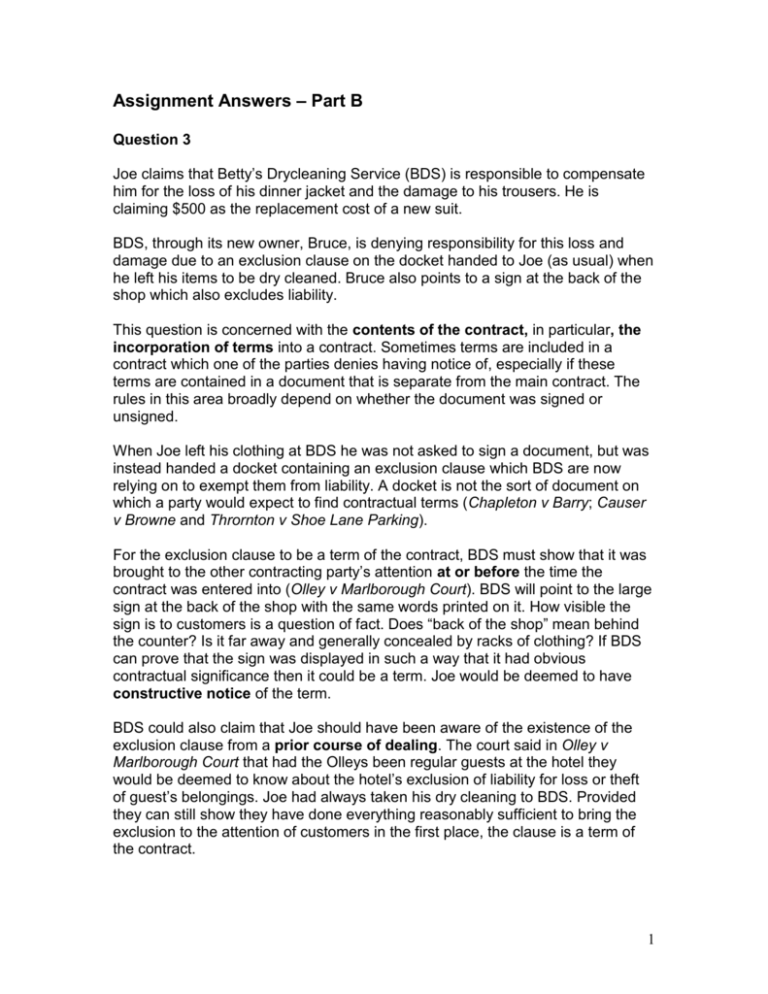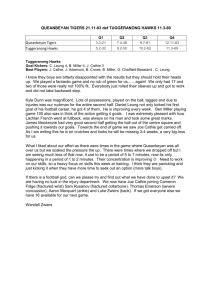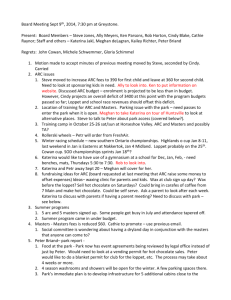Assignment Answers – Part B
advertisement

Assignment Answers – Part B Question 3 Joe claims that Betty’s Drycleaning Service (BDS) is responsible to compensate him for the loss of his dinner jacket and the damage to his trousers. He is claiming $500 as the replacement cost of a new suit. BDS, through its new owner, Bruce, is denying responsibility for this loss and damage due to an exclusion clause on the docket handed to Joe (as usual) when he left his items to be dry cleaned. Bruce also points to a sign at the back of the shop which also excludes liability. This question is concerned with the contents of the contract, in particular, the incorporation of terms into a contract. Sometimes terms are included in a contract which one of the parties denies having notice of, especially if these terms are contained in a document that is separate from the main contract. The rules in this area broadly depend on whether the document was signed or unsigned. When Joe left his clothing at BDS he was not asked to sign a document, but was instead handed a docket containing an exclusion clause which BDS are now relying on to exempt them from liability. A docket is not the sort of document on which a party would expect to find contractual terms (Chapleton v Barry; Causer v Browne and Thrornton v Shoe Lane Parking). For the exclusion clause to be a term of the contract, BDS must show that it was brought to the other contracting party’s attention at or before the time the contract was entered into (Olley v Marlborough Court). BDS will point to the large sign at the back of the shop with the same words printed on it. How visible the sign is to customers is a question of fact. Does “back of the shop” mean behind the counter? Is it far away and generally concealed by racks of clothing? If BDS can prove that the sign was displayed in such a way that it had obvious contractual significance then it could be a term. Joe would be deemed to have constructive notice of the term. BDS could also claim that Joe should have been aware of the existence of the exclusion clause from a prior course of dealing. The court said in Olley v Marlborough Court that had the Olleys been regular guests at the hotel they would be deemed to know about the hotel’s exclusion of liability for loss or theft of guest’s belongings. Joe had always taken his dry cleaning to BDS. Provided they can still show they have done everything reasonably sufficient to bring the exclusion to the attention of customers in the first place, the clause is a term of the contract. 1 If the exclusion clause is a term of the contract, the next issue is to determine what it excludes liability for. Exclusion clauses usually exclude liability for loss caused by one party’s breach of contract. Very definite words are required to exclude liability for negligence as well. Where a clause is ambiguous it will be interpreted contra proferentum, that is, against the party seeking to rely on it. The clause in this case is wide enough to cover breach of contract and negligence where it refers to “any loss or damage…howsoever…caused”. The tear to Joe’s trousers is something that BDS have excluded liability for, therefore, Joe is precluded from claiming damages for this loss. In relation to the missing jacket Joe will argue that the exclusion clause did not cover this type of loss; that is, “Bruce Ocker” was not authorised to give Joe’s jacket to any person claiming to be Joe’s “friend” without a docket. This is the application of the four corners rule. An exclusion clause excludes liability in the performance of the contract, not for loss or damage on account of acts done outside the contemplated performance of the contract (Sydney City Council v West and TNT v May & Baker). The act of giving Joe’s jacket to a stranger was not contemplated by the parties when they entered into the contract, therefore, BDS cannot rely on the exclusion clause to exclude its liability for the loss of the jacket. Conclusion: the exclusion clause has been incorporated into the contract through constructive notice, including a prior course of dealing; the exclusion is wide enough to cover loss or damage from breach of contract and negligence; the clause covers the damage to the trousers, but not the loss of the jacket; the loss of the jacket is outside the four corners of the contract, therefore BDS must pay damages to replace the jacket. NOTES TO MARKERS PASS: students should recognise that the problem concerns exclusion clauses. An exclusion clause should be defined. The principles for the incorporation of exclusion terms in contracts should be discussed. Some case references should be provided. CREDIT: in addition to the above information, students should discuss the four corners rule, differentiating between the tear to the trousers and the loss of the jacket. DISTINCTION: a succinct discussion of all the issues raised in the problem, including appropriate case references. 2 Question 4 Cathie wants to rescind the contract and have her money returned on the ground that the scooter’s engine was completely worn and had never been overhauled, despite Gypsy Angel’s assurances. This problem is concerned with the contents of the contract, including what are the terms and vitiating factors, including misrepresentation and unconscionable conduct. Cathie will claim that Mr Gypsy Angel’s (GA) assurances about the condition of the scooter (that it is in perfect condition and the engine had just been overhauled) were terms of the contract. GA will refer to the written agreement which contains a clause stating that no warranty is given about the engine or any part of the scooter. Even though Cathie signed the contract without reading it she is still bound by its terms. Further, the parol evidence rule will support GA’s contention that the “Contract of Sale” contains all the terms of the agreement. As these terms are clear and unambiguous, no evidence can be admitted to alter their interpretation (Mercantile Bank of Sydney v Taylor). Cathie will claim that the “Contract of Sale” was not the complete record of their agreement. She will assert that it is a partly written, partly oral contract. Applying the guidelines for the incorporation of oral terms it is possible to show that the assurances about the engine are terms of the contract: timing of the statement – GA’s assurances about the engine were made just before the signing of the contract. This is similar to Van den Esschert v Chappell where the vendor’s assurance, just before signing the contract, that the house had been treated for white ants, was treated as a term; where one of the parties has special skill and knowledge – GA is a Motorcycle dealer – he has more knowledge about scooters and their engines than Cathie (Dick Bentley Productions v Harold Smith Motors); importance of the statement – Cathie repeated a request for assurance that the engine would go well, indicating that the statement about the engine was important in the minds of both parties (Couchman v Hill). Cathie will face one main problem in trying to prove that it is a partly written, partly oral contract. The clause in the written contract stating that there is no warranty as to the condition of the engine prevents there from being any oral term about the engine’s condition. 3 Cathie could claim that the promise made about the engine’s condition is a term of a separate or collateral contract which is supported by the consideration of entering into the main contract (Heilbut Symons & Co v Buckleton). The requirements of a collateral contract are as follows: The statement must have been promissory and not merely representational (Savage v Blakney) – GA’s statement “you’ll have no worries” is a promise that the engine is in good condition. The promise must have induced the contract (De Lassalle v Guildford) – Cathie would not have entered into the contract unless assured that the engine was in good condition. There must be no inconsistency between the collateral contract and the terms of the main contract (Hoyts v Spencer) – this is an area of difficulty for Cathie because the written contract denies the existence of any warranty regarding the engine’s condition, whereas the verbal promise includes a warranty as to the engine’s condition. The two cannot coexist. Cathie would succeed in an action for misrepresentation. GA has made a statement of fact about the engine (“just overhauled”) that is false and which has induced Cathie to enter into the contract. As a consequence of GA’s misrepresentation Cathie has suffered loss or damage (i.e. the cost of the scooter). It is fraudulent misrepresentation because GA knew that the engine had not been overhauled and had deliberately lied to procure the sale. Cathie can rescind the contract and claim damages in the tort of deceit (Derry v Peek). Cathie could rescind the contract for unconscionable conduct. GA has exploited the inequality in bargaining power that exists between him and Cathie. He is in a much stronger position as a motorcycle dealer compared to her weaker position as having recently arrived from China and knowing very little about motor-scooters (CBA v Amadio). Conclusion the parol evidence rule supports GA’s contention that the “Contract of Sale” contains all the terms of the agreement; Cathie will argue that the contract is partly written, partly oral or that there is a separate or collateral contract; Cathie will seek rescission of the contract and claim damages in tort for fraudulent misrepresentation. Cathie could rescind the contract for unconscionable conduct. 4 NOTES TO MARKERS PASS: students should recognise that the problem is about the contents of the contract. They will need to consider whether it is a partly written, oral contract and collateral agreement, explaining the requirements for each. Misrepresentation should be briefly explained. CREDIT: as above, including explanations why there cannot be a partly written/oral contract or a collateral agreement. Students need to describe what type of misrepresentation it is and the remedies. Unconscionable conduct should be explained as a possible ground for rescission. Appropriate case references should be given. DISTINCTION: a succinct discussion of all the issues raised in the problem, including appropriate case references. NOTE: If your class had not covered misrepresentation by the due date for this assignment, then please do not penalise students for failing to mention it. 5







